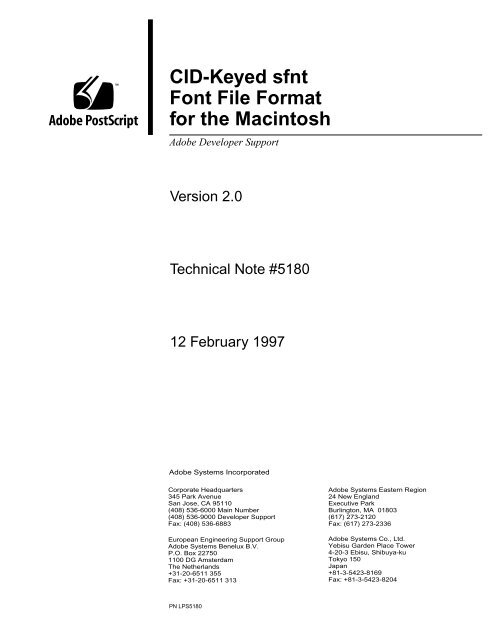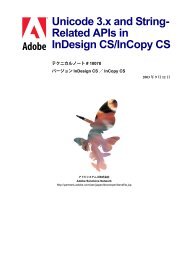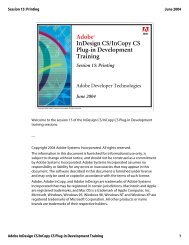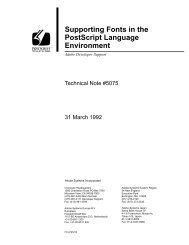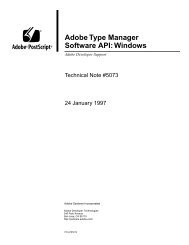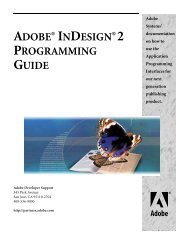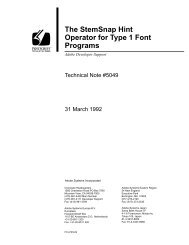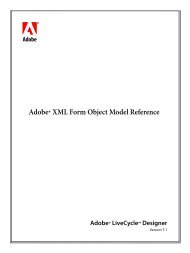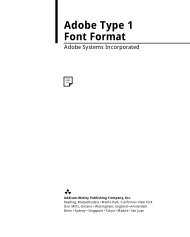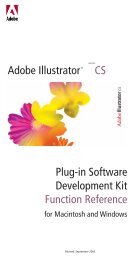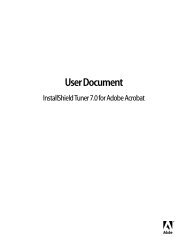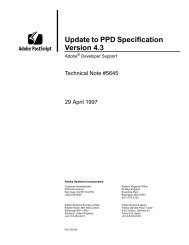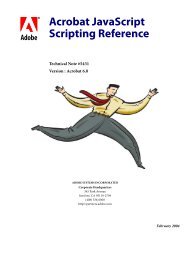CID-Keyed sfnt Font File Format for the Macintosh - Adobe Partners
CID-Keyed sfnt Font File Format for the Macintosh - Adobe Partners
CID-Keyed sfnt Font File Format for the Macintosh - Adobe Partners
You also want an ePaper? Increase the reach of your titles
YUMPU automatically turns print PDFs into web optimized ePapers that Google loves.
Copyright © 1994, 1996, 1997 by <strong>Adobe</strong> Systems Incorporated. All rights reserved.No part of this publication may be reproduced, stored in a retrieval system, or transmitted, in any <strong>for</strong>mor by any means, electronic, mechanical, photocopying, recording, or o<strong>the</strong>rwise, without <strong>the</strong> priorwritten consent of <strong>the</strong> publisher. Any software referred to herein is furnished under license and mayonly be used or copied in accordance with <strong>the</strong> terms of such license.PostScript is a trademark of <strong>Adobe</strong> Systems Incorporated. All instances of <strong>the</strong> name PostScript in <strong>the</strong>text are references to <strong>the</strong> PostScript language as defined by <strong>Adobe</strong> Systems Incorporated unless o<strong>the</strong>rwisestated. The name PostScript also is used as a product trademark <strong>for</strong> <strong>Adobe</strong> Systems’ implementationof <strong>the</strong> PostScript language interpreter.Any references to a “PostScript printer,” a “PostScript file,” or a “PostScript driver” refer to printers,files, and driver programs (respectively) which are written in or support <strong>the</strong> PostScript language. Thesentences in this book that use “PostScript language” as an adjective phrase are so constructed to rein<strong>for</strong>cethat <strong>the</strong> name refers to <strong>the</strong> standard language definition as set <strong>for</strong>th by <strong>Adobe</strong> Systems Incorporated.<strong>Adobe</strong>, <strong>Adobe</strong> Type Manager, ATM, Display PostScript, PostScript and <strong>the</strong> PostScript logo are trademarksof <strong>Adobe</strong> Systems Incorporated which may be registered in certain jurisdictions. Apple and<strong>Macintosh</strong> are registered trademarks and QuickDraw and TrueType are trademarks of Apple ComputerIncorporated. Microsoft and Windows are registered trademarks of Microsoft Corporation. CJK is aregistered trademark and service mark of The Research Libraries Group, Inc. All o<strong>the</strong>r brand or productnames are <strong>the</strong> trademarks or registered trademarks of <strong>the</strong>ir respective holders.This publication and <strong>the</strong> in<strong>for</strong>mation herein is furnished AS IS, is subject to change without notice, andshould not be construed as a commitment by <strong>Adobe</strong> Systems Incorporated. <strong>Adobe</strong> Systems Incorporatedassumes no responsibility or liability <strong>for</strong> any errors or inaccuracies, makes no warranty of anykind (express, implied or statutory) with respect to this publication, and expressly disclaims any andall warranties of merchantability, fitness <strong>for</strong> particular purposes and noninfringement of third partyrights.
iv (12 Feb 97)
<strong>CID</strong>-<strong>Keyed</strong> <strong>sfnt</strong><strong>Font</strong> <strong>File</strong> <strong>Format</strong><strong>for</strong> <strong>the</strong> <strong>Macintosh</strong>1 IntroductionThis document describes <strong>the</strong> <strong>CID</strong> <strong>sfnt</strong> font <strong>for</strong>mat <strong>for</strong> <strong>the</strong> <strong>Macintosh</strong>. Itdescribes only those extensions made by <strong>Adobe</strong> to Apple’s <strong>for</strong>mat to accommodate<strong>CID</strong>-keyed fonts. Also, it assumes familiarity with <strong>the</strong> <strong>sfnt</strong> specificationpublished by Apple Computer (see Appendix B).A <strong>CID</strong>-keyed <strong>sfnt</strong> font consists of a PostScript <strong>CID</strong>-keyed font program (<strong>the</strong><strong>CID</strong><strong>Font</strong>) embedded in a subtable of a <strong>sfnt</strong> wrapper. The <strong>CID</strong>-keyed <strong>for</strong>matwas designed <strong>for</strong> maximum flexibility and per<strong>for</strong>mance <strong>for</strong> large characterset fonts such as <strong>for</strong> Chinese, Japanese, and Korean (CJK) language fonts.The <strong>for</strong>mat supports both regular and rearranged <strong>CID</strong>-keyed fonts.For more in<strong>for</strong>mation on <strong>the</strong> <strong>CID</strong>-keyed font file <strong>for</strong>mat, see <strong>Adobe</strong> TechnicalNote #5014, “<strong>Adobe</strong> CMap and <strong>CID</strong><strong>Font</strong> <strong>File</strong>s Specification,” and #5092,“<strong>CID</strong>-<strong>Keyed</strong> <strong>Font</strong> Technology Overview.” Also, a <strong>CID</strong> Software DevelopersKit (SDK) is available from <strong>the</strong> <strong>Adobe</strong> Developers Association.This document describes only a few tables beyond <strong>the</strong> minimum numberrequired <strong>for</strong> a <strong>CID</strong> <strong>sfnt</strong> font. For example, <strong>the</strong> ALMX table allows <strong>the</strong> specificationof alternate metrics <strong>for</strong> proportionally spaced characters. Also, anumber of o<strong>the</strong>r advanced features can be supported by using <strong>the</strong> mort table(<strong>the</strong> <strong>for</strong>mat of <strong>the</strong> mort table is specified in <strong>the</strong> Apple documentation).This document also includes:• Appendix A: <strong>sfnt</strong> Data Types• Appendix B: Bibliography• Appendix C: Glossary• Appendix D: <strong>sfnt</strong> Binary Search and Lookup Table <strong>Format</strong>s1
1.1 Purpose of this DocumentThis document describes how to make <strong>CID</strong>-keyed fonts <strong>for</strong> use in future<strong>Macintosh</strong> operating systems which are likely to support only fonts in <strong>the</strong> <strong>sfnt</strong><strong>for</strong>mat. <strong>Font</strong> developers who currently have <strong>CID</strong>-keyed fonts, or PostScriptlanguage OCF (Original Composite <strong>Format</strong>) fonts, must convert <strong>the</strong>se into<strong>the</strong> <strong>sfnt</strong> <strong>for</strong>mat <strong>for</strong> use with future <strong>Macintosh</strong> systems. OCF fonts can be convertedto <strong>the</strong> <strong>CID</strong>-keyed font file <strong>for</strong>mat, and a <strong>CID</strong>-keyed font can be convertedinto <strong>the</strong> <strong>sfnt</strong> <strong>for</strong>mat by embedding <strong>the</strong> <strong>CID</strong><strong>Font</strong> into a subtable of <strong>the</strong><strong>sfnt</strong> resource.For <strong>the</strong> future, <strong>the</strong> best way to develop full-featured fonts <strong>for</strong> <strong>the</strong> broadestpossible market will be to use <strong>the</strong> new OpenType font <strong>for</strong>mat, which isbeing jointly developed by <strong>Adobe</strong> Systems and Microsoft Corporation. For<strong>the</strong> immediate future, developers who wish to make multi-byte fonts <strong>for</strong> <strong>the</strong>upcoming <strong>Macintosh</strong> operating systems should use <strong>the</strong> <strong>CID</strong> <strong>sfnt</strong> <strong>for</strong>mat.Both <strong>the</strong> <strong>sfnt</strong> and OpenType <strong>for</strong>mats are essentially font packaging <strong>for</strong>matswhich allow <strong>the</strong> embedding of a <strong>CID</strong>-keyed font as a single subtable. Thismeans that it should be relatively easy, in <strong>the</strong> future, <strong>for</strong> font developers toconvert <strong>CID</strong> <strong>sfnt</strong> fonts into <strong>the</strong> OpenType <strong>for</strong>mat.1.2 Conventions Used in this DocumentIn this document, all <strong>sfnt</strong> table names and table elements are represented in asans serif typeface, and PostScript language and Type 1 font program operatorsare represented in a bold sans serif style.References to documents include full in<strong>for</strong>mation in <strong>the</strong> first reference, andsubsequent references may use a shortened <strong>for</strong>m. Please refer to Appendix B<strong>for</strong> complete bibliographic in<strong>for</strong>mation.2 The <strong>CID</strong> <strong>sfnt</strong> <strong>Format</strong>A <strong>CID</strong> <strong>sfnt</strong> font consists of an <strong>sfnt</strong> “wrapper” that contains a complete<strong>CID</strong><strong>Font</strong> as a subtable. The tables in <strong>the</strong> <strong>sfnt</strong> wrapper are identified by uniquefour-character tags – <strong>for</strong> example, ‘cmap’. The names of all data tablesdefined by Apple use all lowercase characters. All non-Apple tables developedby <strong>Adobe</strong> are in all uppercase letters – <strong>for</strong> example,‘<strong>CID</strong>’.A <strong>CID</strong> <strong>sfnt</strong> font is distinguished from a TrueType font by having <strong>the</strong> tag‘typ1’ stored in <strong>the</strong> 4-byte Fixed version field of <strong>the</strong> <strong>sfnt</strong> header (see Table 1),whereas a TrueType font has ei<strong>the</strong>r <strong>the</strong> tag ‘true’, or <strong>the</strong> value 1.0. A <strong>CID</strong>keyedType 1 <strong>sfnt</strong> font is distinguished from a Type 1 Roman <strong>sfnt</strong> font by <strong>the</strong>presence of a <strong>CID</strong> table, and <strong>the</strong> absence of a TYP1 table.2 <strong>CID</strong>-<strong>Keyed</strong> <strong>sfnt</strong> <strong>Font</strong> <strong>File</strong> <strong>Format</strong> <strong>for</strong> <strong>the</strong> <strong>Macintosh</strong> (12 Feb 97)
3 <strong>CID</strong> <strong>sfnt</strong> <strong>Font</strong> <strong>Format</strong> Overview<strong>Macintosh</strong> <strong>sfnt</strong> fonts are required to be part of a suitcase (an FFIL resourcefile). Additionally, <strong>the</strong> suitcase must contain at least one FOND resource, andmay optionally contain o<strong>the</strong>r resources such as bitmap fonts (NFNTresources) <strong>for</strong> screen display.Figure 1 <strong>sfnt</strong> <strong>Font</strong> <strong>File</strong> Organizationheader<strong>sfnt</strong>resourceo<strong>the</strong>rresourcesFOND resourceNFNT resourcemapIn<strong>for</strong>mation on how <strong>Macintosh</strong> resources are constructed is contained inInside <strong>Macintosh</strong> – More <strong>Macintosh</strong> Toolbox; Chapter 1: Resource Manager.Figure 2 shows <strong>the</strong> contents of <strong>the</strong> <strong>sfnt</strong> resource. The tables may be in anyorder, but <strong>the</strong> Table List entries must be sorted into tag order.Figure 2 Layout of <strong>the</strong> <strong>sfnt</strong>Table List EntrytagchecksumoffsetlengthHeaderTableList<strong>CID</strong>cmapTableDirectoryTablesVFMX4 <strong>CID</strong>-<strong>Keyed</strong> <strong>sfnt</strong> <strong>Font</strong> <strong>File</strong> <strong>Format</strong> <strong>for</strong> <strong>the</strong> <strong>Macintosh</strong> (12 Feb 97)
The contents of <strong>the</strong> <strong>sfnt</strong> Header are shown in Table 1.Table 1 <strong>sfnt</strong> HeaderTypeFixeduint16uint16uint16uint16FieldversionnumTablessearchRangeentrySelectorrangeShiftThe version field originally contained <strong>the</strong> <strong>sfnt</strong> <strong>for</strong>mat version number, 1.0(0x00010000). However, <strong>the</strong> purpose changed with <strong>the</strong> introduction ofQuickDraw GX, and this field is now used to identify a rasterizer <strong>for</strong> <strong>the</strong> font.Type 1 fonts use <strong>the</strong> tag ‘typ1’; older TrueType fonts use <strong>the</strong> value 1.0(0x00010000), and newer TrueType fonts use <strong>the</strong> tag ‘true’ as <strong>the</strong> value <strong>for</strong>this field.The numTables field specifies <strong>the</strong> number of entries in <strong>the</strong> Table List (whereeach entry has four fields, as shown in Table 2).The searchRange, entrySelector, and rangeShift fields provide valuesintended to speed <strong>the</strong> binary search of <strong>the</strong> Table List. Please consult“QuickDraw GX <strong>Font</strong> <strong>Format</strong>s: The TrueType <strong>Font</strong> <strong>Format</strong> Specification” <strong>for</strong>more in<strong>for</strong>mation.Following <strong>the</strong> <strong>sfnt</strong> Header is <strong>the</strong> Table List, where each entry identifies andpoints to one table in <strong>the</strong> <strong>sfnt</strong> as shown in Table 2.Table 2 Table List EntryTypeuint32uint32uint32uint32FieldtagchecksumoffsetlengthThe tag field identifies <strong>the</strong> table by using an ASCII representation of <strong>the</strong>table’s name. Table names shorter than four characters are padded with <strong>the</strong>code <strong>for</strong> a blank character.The checksum field contains a checksum of all bytes contained in <strong>the</strong> table.3 <strong>CID</strong> <strong>sfnt</strong> <strong>Font</strong> <strong>Format</strong> Overview 5
The offset field contains <strong>the</strong> byte offset from <strong>the</strong> beginning of <strong>the</strong> <strong>sfnt</strong> to <strong>the</strong>start of <strong>the</strong> table.The length field contains <strong>the</strong> length of <strong>the</strong> table in bytes. Note that each <strong>sfnt</strong>table is padded to a long-word (4-byte) boundary.3.1 Guidelines <strong>for</strong> Version CheckingVersion numbers <strong>for</strong> individual <strong>sfnt</strong> tables are stored as 4-byte Fixed valuesand are of <strong>the</strong> <strong>for</strong>m x.y, where x is <strong>the</strong> major version number, and y is <strong>the</strong>minor version number. Following Apple’s convention, <strong>the</strong> version numbersare represented in a hexadecimal <strong>for</strong>mat; <strong>for</strong> example, version 1.1 is representedas 0x00010001.Applications should always check <strong>the</strong> version number of all <strong>sfnt</strong> tables be<strong>for</strong>e<strong>the</strong>y are used. Each revision or extension of a table will be documented in thisspecification.If <strong>the</strong> major version number is greater than <strong>the</strong> version understood by <strong>the</strong>application, <strong>the</strong> table should not be read and <strong>the</strong> application should take <strong>the</strong>appropriate action. Minor revisions are those that allow <strong>the</strong> application tosafely ignore, <strong>for</strong> example, fields added to <strong>the</strong> end of a table. If differences in<strong>the</strong> minor version are found, some in<strong>for</strong>mation may not be used, but use of<strong>the</strong> font file can continue safely.3.2 Overview of <strong>CID</strong> <strong>sfnt</strong> TablesA <strong>CID</strong> <strong>sfnt</strong> font must contain <strong>the</strong> cmap, fdsc, and name tables. The followingtables are specific to <strong>CID</strong>-keyed <strong>sfnt</strong> fonts:ALMX (required if proportionally-spaced characters are included in <strong>the</strong> font)The Alternate Metrics table (ALMX) specifies <strong>the</strong> metrics <strong>for</strong> proportionallyspaced characters.BBOX (required)This table specifies bounding boxes <strong>for</strong> all glyphs in <strong>the</strong> font.<strong>CID</strong> (required)This table contains <strong>the</strong> <strong>CID</strong><strong>Font</strong> file. For a rearranged <strong>CID</strong> font, it containsencoding in<strong>for</strong>mation ra<strong>the</strong>r than glyph descriptions.COFN (required <strong>for</strong> rearranged <strong>CID</strong> <strong>sfnt</strong> fonts)Table used only <strong>for</strong> rearranged <strong>CID</strong> <strong>sfnt</strong> fonts; it contains <strong>the</strong> QuickDraw fontname <strong>for</strong> each component font used in <strong>the</strong> rearranged font.COSP (required <strong>for</strong> rearranged <strong>CID</strong> <strong>sfnt</strong> fonts)This table, used only <strong>for</strong> rearranged <strong>CID</strong> <strong>sfnt</strong> fonts, defines <strong>the</strong> code space ofa rearranged font.6 <strong>CID</strong>-<strong>Keyed</strong> <strong>sfnt</strong> <strong>Font</strong> <strong>File</strong> <strong>Format</strong> <strong>for</strong> <strong>the</strong> <strong>Macintosh</strong> (12 Feb 97)
FNAM (required <strong>for</strong> QuickDraw compatibility)This table maps FOND resource names and styles and is used <strong>for</strong> compatibilitywith QuickDraw.HFMX (required)This table provides font metric in<strong>for</strong>mation related to setting horizontal linesof text. These values are font-wide metrics such as ascent, descent, line gapand caret in<strong>for</strong>mation values.VFMX (required)This table provides vertical metric in<strong>for</strong>mation such as <strong>the</strong> per-glyph verticaladvance and origin shift in<strong>for</strong>mation.The following sections give a more detailed description of <strong>the</strong> <strong>CID</strong>-keyedfont–specific tables in a <strong>CID</strong> <strong>sfnt</strong> font. The tables are discussed in alphabeticorder.NoteA number of tables contain fields that duplicate in<strong>for</strong>mation stored elsewherein <strong>the</strong> font. While redundant, this makes <strong>the</strong>se tables more self-contained andsimplify <strong>the</strong>ir use.4 ALMXThe ALMX table provides <strong>for</strong> alternate metrics that override <strong>the</strong> existing metricsof <strong>the</strong> glyphs in <strong>the</strong> <strong>CID</strong>-keyed font. The new glyphs defined in this tableare intended to be used with non-contextual glyph substitution <strong>for</strong> proportionalJapanese fonts.The ALMX table consists of a header followed by a Lookup table, as shown inFigure 3. The Lookup table may be in <strong>for</strong>mat 0, 2, 4, 6, or 8, as described inAppendix E.Figure 3 The ALMX TableALMX HeaderALMX LookupTableThe <strong>for</strong>mat of <strong>the</strong> ALMX Header table is shown in Table 3.4 ALMX 7
Table 3 ALMX Header TableTypeFixeduint16uint16uint16uint16FieldversionflagsnMastersfirstGlyphlastGlyphThe version field should be set to 1.0 (0x00010000).The flags field is reserved <strong>for</strong> future use, and should be set to zero.The nMasters field must have a value of 1 (<strong>for</strong> non-multiple master fonts).firstGlyph is <strong>the</strong> first index of valid glyphs specified in <strong>the</strong> lookup table.lastGlyph is <strong>the</strong> last index of valid glyphs specified in <strong>the</strong> lookup table.The ALMX Lookup Table consists of a header followed by a lookup data section,as shown in Figure 4.Figure 4 ALMX Lookup TableALMX LookupTable HeaderALMX LookupTable SegmentsOptional SubtablesThe <strong>for</strong>mat of <strong>the</strong> ALMX Lookup Table can be any one of <strong>the</strong> five lookup table<strong>for</strong>mats; Table 4 shows <strong>the</strong> <strong>for</strong>m used <strong>for</strong> <strong>for</strong>mats 0, 2, 6, and 8.Table 4 ALMX Lookup Data <strong>for</strong> <strong>Format</strong>s 0, 2, 6, and 8TypeALMXDataEntryFieldALMXDataEntry8 <strong>CID</strong>-<strong>Keyed</strong> <strong>sfnt</strong> <strong>Font</strong> <strong>File</strong> <strong>Format</strong> <strong>for</strong> <strong>the</strong> <strong>Macintosh</strong> (12 Feb 97)
The contents of <strong>the</strong> ALMXDataEntry is shown in Table 5. This <strong>for</strong>mat is used<strong>for</strong> <strong>the</strong> Lookup Table segments as well as <strong>for</strong> any optional subtables that maybe present.Table 5 ALMXDataEntryTypeint16FUnitFUnitFUnitFUnitFieldglyphIndexOffsethorizontalAdvancexOffsetToHOriginverticalAdvanceyOffsetToVOriginglyphIndexOffset is <strong>the</strong> offset to <strong>the</strong> glyph index of <strong>the</strong> glyph whose metricsare being modified.horizontalAdvance specifies <strong>the</strong> horizontal advance of <strong>the</strong> glyph in <strong>the</strong> horizontalwriting mode (specified in FUnits).xOffsetToHOrigin specifies <strong>the</strong> horizontal offset from <strong>the</strong> original origin to <strong>the</strong>new origin in <strong>the</strong> horizontal writing mode (specified in FUnits).verticalAdvance specifies <strong>the</strong> vertical advance of <strong>the</strong> glyph in <strong>the</strong> verticalwriting mode (specified in FUnits).yOffsetToVOrigin specifies <strong>the</strong> vertical offset from <strong>the</strong> original origin to <strong>the</strong>new origin in <strong>the</strong> vertical writing mode (specified in FUnits).Table 6 ALMX Lookup Data <strong>for</strong> <strong>Format</strong> 4Typeuint8uint24FieldflagsoffsetToSubTableThe flags field is defined as shown in Table 7.Table 7 flags Values <strong>for</strong> <strong>the</strong> ALMX Lookup DataNameONE_ENTRY_IN_SUBTABLEValue0x804 ALMX 9
The flags field may have a flag ONE_ENTRY_IN_SUBTABLE set to indicatethat <strong>the</strong>re is only one entry in <strong>the</strong> subtable. The o<strong>the</strong>r bits are reserved <strong>for</strong>future use, and should be set to zero.The offsetToSubTable field contains <strong>the</strong> offset to <strong>the</strong> subtable, which is shownin Table 8.Table 8 ALMX SubTableTypeALMXDataEntryFieldALMXSubTableEntry[]The number of entries contained in ALMXSubTableEntry <strong>for</strong> a lookup segmentdepends on <strong>the</strong> value of <strong>the</strong> flags bit. Each lookup data has an offsetfrom <strong>the</strong> start of <strong>the</strong> lookup table to <strong>the</strong> subtable which contains <strong>the</strong> metricsin<strong>for</strong>mation. When <strong>the</strong> ONE_ENTRY_IN_SUBTABLE flag is set in flags, <strong>the</strong>reis only one entry in <strong>the</strong> subtable, and <strong>the</strong> metrics in <strong>the</strong> entry applies to allglyphs in <strong>the</strong> segment. When this bit is not set, <strong>the</strong> subtable has one entry <strong>for</strong>each glyph in <strong>the</strong> segment, and it is indexed by <strong>the</strong> glyph index minus <strong>the</strong> firstglyph index in <strong>the</strong> lookup segment.Figure 5 shows <strong>the</strong> character metrics values associated with a glyph referencedby an entry in <strong>the</strong> ALMX table.Figure 5 Alternate Metrics ExampleOld V OriginYOffsetToVOrigin(ALMX)New V OriginX/YOffsetToVOrigin(VFMX)Vertical Advance(ALMX)XOffsetToHOrigin(ALMX)Old H OriginNew H OriginHorizontal Advance(ALMX)Typical uses of <strong>the</strong> ALMX table are as follows. When GlyphIndexOffset iszero, <strong>the</strong> <strong>CID</strong> glyph with <strong>the</strong> same glyph index used to index this table isredefined to have <strong>the</strong> new metrics specified in this table. When <strong>the</strong> GlyphIn-10 <strong>CID</strong>-<strong>Keyed</strong> <strong>sfnt</strong> <strong>Font</strong> <strong>File</strong> <strong>Format</strong> <strong>for</strong> <strong>the</strong> <strong>Macintosh</strong> (12 Feb 97)
dexOffset is not zero, a new glyph is defined based on <strong>the</strong> glyph whose glyphindex is calculated by adding GlyphIndexOffset to <strong>the</strong> glyph index of thisglyph.If <strong>the</strong> listed metrics value is greater than 32000, <strong>the</strong> default metrics of <strong>the</strong>specified glyph charstring are used.If a glyph has metrics specified in both <strong>the</strong> ALMX and VFMX table, <strong>the</strong> metricsspecified in <strong>the</strong> ALMX table override those in <strong>the</strong> VFMX table.5 BBOXThe BBOX table specifies <strong>the</strong> bounding boxes <strong>for</strong> all <strong>the</strong> glyphs in <strong>the</strong> font.Table 9 BBOX TableTypeFixeduint16uint16uint16BBoxFieldversionflagsnGlyphsnMastersbbox[nGlyphs]The version field should be set to 1.0 (0x00010000).The flags field is reserved <strong>for</strong> future use, and should be set to 0.The nGlyphs field specifies <strong>the</strong> number of glyphs in <strong>the</strong> font. Its value is equalto <strong>the</strong> <strong>CID</strong>Count field <strong>for</strong> a <strong>CID</strong>-keyed font.The nMasters field must have a value of 1 <strong>for</strong> non–multiple master fonts.bbox is an array of BBox elements, described below.Table 10 BBox ElementTypeFWordFWordFWordFWordFieldleftbottomrighttopThe metric left is <strong>the</strong> minimum x-coordinate of <strong>the</strong> glyph bounding box.5 BBOX 11
The metric bottom is <strong>the</strong> minimum y-coordinate of <strong>the</strong> glyph bounding box.The metric right is <strong>the</strong> maximum x-coordinate of <strong>the</strong> glyph bounding box.The metric top is <strong>the</strong> maximum y-coordinate of <strong>the</strong> glyph bounding box.6 <strong>CID</strong>The <strong>CID</strong> table consists of two parts, <strong>the</strong> <strong>CID</strong> Header table, and <strong>the</strong> <strong>CID</strong><strong>Font</strong>data, which contains <strong>the</strong> glyphs. The layout of <strong>the</strong> <strong>CID</strong> table is shown inFigure 6.Figure 6 <strong>CID</strong> Table Layout<strong>CID</strong> Header<strong>CID</strong><strong>Font</strong> DataThe contents of <strong>the</strong> table depends on whe<strong>the</strong>r <strong>the</strong> <strong>CID</strong> font is a regular <strong>CID</strong>keyedfont, or a rearranged <strong>CID</strong>-keyed font. The <strong>for</strong>mat <strong>for</strong> a regular <strong>CID</strong>keyed<strong>sfnt</strong> font is shown in Table 11.Table 11 <strong>CID</strong> Header TableTypeFixeduint16uint16uint32uint32uint32uint16Fieldversionflags<strong>CID</strong>Count<strong>CID</strong><strong>Font</strong>LengthasciiLengthbinaryLengthFDCountThe version field should be set to 1.0 (0x00010000).The flags field bits are defined in Table 12.12 <strong>CID</strong>-<strong>Keyed</strong> <strong>sfnt</strong> <strong>Font</strong> <strong>File</strong> <strong>Format</strong> <strong>for</strong> <strong>the</strong> <strong>Macintosh</strong> (12 Feb 97)
Table 12 flags Values <strong>for</strong> <strong>the</strong> <strong>CID</strong> TableName Value Description<strong>CID</strong>_REARRANGED_FONT 0x0001 Specifies a rearranged <strong>CID</strong>fontThe flags field may have a flag <strong>CID</strong>_REARRANGED_FONT set to indicatethat <strong>the</strong> font is a rearranged font. If not set, <strong>the</strong> font is a <strong>CID</strong> font. The o<strong>the</strong>rbits are reserved and should be set to zero.Continuing with <strong>the</strong> entries in <strong>the</strong> <strong>CID</strong> Header table, <strong>CID</strong>Count must be equalto <strong>the</strong> value specified by <strong>the</strong> <strong>CID</strong>Count key in <strong>the</strong> <strong>CID</strong><strong>Font</strong>. For a rearranged<strong>CID</strong> <strong>sfnt</strong> font, this value must be set to <strong>the</strong> total number of glyph indicesassigned in <strong>the</strong> rearranged font.<strong>CID</strong><strong>Font</strong>Length is <strong>the</strong> total length of this table excluding <strong>the</strong> header part.AsciiLength is <strong>the</strong> length of <strong>the</strong> ASCII part of <strong>the</strong> <strong>CID</strong><strong>Font</strong>, and it is equal to<strong>the</strong> file offset to <strong>the</strong> beginning of <strong>the</strong> binary section of <strong>the</strong> <strong>CID</strong><strong>Font</strong>.BinaryLength is <strong>the</strong> length of <strong>the</strong> binary section of <strong>the</strong> <strong>CID</strong><strong>Font</strong>.FDCount is <strong>the</strong> number of font dictionaries defined in <strong>the</strong> FDArray of <strong>the</strong><strong>CID</strong>-keyed font.6.1 <strong>CID</strong> Table <strong>for</strong> a Rearranged <strong>CID</strong> <strong>Font</strong>If <strong>the</strong> <strong>CID</strong>_REARRANGED_FONT flag is set, <strong>the</strong>n <strong>the</strong> font is a rearranged<strong>CID</strong> font. For a rearranged <strong>CID</strong> font, <strong>the</strong> AsciiLength specifies <strong>the</strong> length of<strong>the</strong> rearrangement recipe part that begins with %ADOStartRearranged<strong>Font</strong>and terminates with %%EndResource. An example of a rearranged <strong>CID</strong> <strong>sfnt</strong>font is shown in Example 1, shown below.BinaryLength field specifies <strong>the</strong> length of <strong>the</strong> rearranged font procset portionat <strong>the</strong> beginning of <strong>the</strong> font.NoteA rearranged font, unlike a <strong>CID</strong><strong>Font</strong>, has a binary section (<strong>the</strong> ProcSet portion)be<strong>for</strong>e <strong>the</strong> ASCII section. It does not contain binary charstrings, it onlyreferences those in <strong>the</strong> component <strong>CID</strong><strong>Font</strong> files.The o<strong>the</strong>r fields, <strong>CID</strong>Count and FDCount, are not used and should be set tozero.The following is an example of a rearranged <strong>CID</strong> font (<strong>for</strong> more in<strong>for</strong>mation,see <strong>Adobe</strong> Technical Note #5014, “<strong>Adobe</strong> CMap and <strong>CID</strong><strong>Font</strong> <strong>File</strong>s Specification1.0.”).6 <strong>CID</strong> 13
In this example, <strong>the</strong> template font is HeiseiMin-W3 (a <strong>CID</strong>-keyed font); kanacharacters from ShinGo-Light have been substituted; Tekton is specified as<strong>the</strong> Roman font. There is a +100 baseline shift (<strong>the</strong> original baseline was at120, so <strong>the</strong> final baseline is at +220/1000 of <strong>the</strong> em space). Also, Gaiji charactersare used from HeiseiMin-W3 Gaiji01.Example 1: Sample Rearranged <strong>CID</strong> <strong>sfnt</strong> <strong>Font</strong>< binary CSL procset data >%ADOStartRearranged<strong>Font</strong>/HeiseiMin-W3-KS-G-RT-90pv-RKSJ-H [/HeiseiMin-W3-90pv-RKSJ-H/Tekton /ShinGo-Light-83pv-RKSJ-H /HeiseiMin-W3-G01]beginrearrangedfont1 beginusematrix [1 0 0 1 0 0.1] endusematrix1 usefont9 beginbfrange endbfrange2 usefont10 beginbfrange endbfrange3 usefont1 beginbfrange endbfrangeendrearrangedfontend%%EndResource7 COFNThe COFN table is used only <strong>for</strong> rearranged <strong>CID</strong> <strong>sfnt</strong> fonts. It is used to specify<strong>the</strong> QuickDraw font name <strong>for</strong> each component font used in <strong>the</strong> rearrangedfont. The COFN table consists of a Header followed by COFN Data, as shownin Figure 7. COFN Data contains one COFN Name Record <strong>for</strong> each Quick-Draw style, as shown in Table 15.14 <strong>CID</strong>-<strong>Keyed</strong> <strong>sfnt</strong> <strong>Font</strong> <strong>File</strong> <strong>Format</strong> <strong>for</strong> <strong>the</strong> <strong>Macintosh</strong> (12 Feb 97)
Figure 7 COFN Table LayoutCOFN HeaderCOFN DataTable 13 shows <strong>the</strong> <strong>for</strong>mat of <strong>the</strong> COFN Header table.Table 13 COFN Header TableTypeFixeduint16uint16Fieldversion (0x00010000)entryCountoffsets[entryCount+1]The version field should be set to 1.0 (0x00010000).entryCount is equal to <strong>the</strong> number of component fonts used in <strong>the</strong> rearrangedfont, and <strong>the</strong> offsets array contains offsets from <strong>the</strong> beginning of <strong>the</strong> COFNtable to each COFNNameRecord entry in <strong>the</strong> COFNData table. The <strong>for</strong>mat of<strong>the</strong> COFNData table is shown in Table 14.Table 14 COFNData TableTypeCOFNNameRecordFieldnameRecord[]A COFNNameRecord entry has a variable length which can be calculated bysubtracting <strong>the</strong> offset <strong>for</strong> <strong>the</strong> chosen entry from <strong>the</strong> offset <strong>for</strong> <strong>the</strong> next entry.For this reason, <strong>the</strong> values in <strong>the</strong> offsets array must be sorted in increasingorder, and one additional offsets entry is required.The <strong>for</strong>mat of each nameRecord entry is shown in Table 15.Table 15 NameRecord TableTypeuint8uint8FieldstyleBitsPString[]7 COFN 15
Table 17 COSP Entry Table ElementTypeuint16uint16uint16FieldnumBytesfirstCodelastCodeEach entry represents one code space range.numBytes is <strong>the</strong> number of bytes of a character code in <strong>the</strong> code space rangerepresented by this entry. The value of numBytes is ei<strong>the</strong>r 1 or 2.firstCode is <strong>the</strong> first character code in <strong>the</strong> range.lastCode is <strong>the</strong> last character code in this range.If numBytes is 1, <strong>the</strong> single byte code is placed in <strong>the</strong> lower byte of firstCodeand lastCode. The upper byte must be zero. The entries must be sorted intoincreasing character code order.A glyph index is assigned to each character code defined in <strong>the</strong> code space, inincreasing order. The glyph index 0 is assigned to <strong>the</strong> first character code in<strong>the</strong> range, 1 is assigned to <strong>the</strong> next, and so on. The glyph indices defined inthis way are used in <strong>the</strong> cmap table of <strong>the</strong> rearranged font.For example, if <strong>the</strong> COSP table elements are as follows:numBytes first last1 20 7F2 8120 9FFC. . .Then <strong>the</strong> corresponding cmap table would look like:char codeglyph index20 021 1. . . . . .7F 958120 968121 97. . . . . .81FC 3158 COSP 17
8220 3168221 317. . . . . .NoteThe total number of glyph indices defined by <strong>the</strong> COSP table must be specifiedin <strong>the</strong> <strong>CID</strong>Count field in <strong>the</strong> <strong>CID</strong> table of a rearranged <strong>CID</strong> <strong>sfnt</strong> font.9 FNAMThe FNAM table provides <strong>Macintosh</strong> QuickDraw compatibility <strong>for</strong> <strong>CID</strong> <strong>sfnt</strong>fonts.The TrueType font <strong>for</strong>mat introduced <strong>sfnt</strong> resources to <strong>the</strong> QuickDraw graphicsmodel, but retained FOND resources as a means of access. QuickDrawaccesses all fonts through FOND resources. These resources were originallydesigned to unite a family of NFNT bitmaps, each containing up to 256glyphs. A typical QuickDraw rasterization request includes a FOND resourceid, an 8-bit character code, a QuickDraw style (bold, italic, etc.), and adesired size. The size and QuickDraw style are used to access a <strong>Font</strong> AssociationTable within <strong>the</strong> FOND and retrieve <strong>the</strong> NFNT id of <strong>the</strong> bitmap to bedisplayed.Figure 9 shows <strong>the</strong> <strong>Font</strong> Association Table in a <strong>Macintosh</strong> FOND resource,with <strong>the</strong> fields <strong>for</strong> Size, Style, and Id. There is one such entry <strong>for</strong> each Quick-Draw style associated with <strong>the</strong> font. A Size value of zero (<strong>the</strong> units are points)indicates that <strong>the</strong> Id is <strong>for</strong> an <strong>sfnt</strong> ra<strong>the</strong>r than <strong>for</strong> an NFNT resource.Figure 9 FOND <strong>Font</strong> Association TableSize Style IdATM also accesses <strong>sfnt</strong> resources under <strong>the</strong> QuickDraw graphics model viaFOND resources. As with TrueType fonts, ATM rasterizer retrieves <strong>the</strong> <strong>sfnt</strong> Idfrom <strong>the</strong> <strong>Font</strong> Association Table entry with <strong>the</strong> appropriate QuickDraw styleand a Size value of 0. The <strong>sfnt</strong> id is <strong>the</strong>n used by <strong>the</strong> Type 1 rasterizer to read<strong>the</strong> <strong>sfnt</strong> resource and rasterize <strong>the</strong> required glyph.One or more QuickDraw FOND resources may refer (via <strong>the</strong> <strong>Font</strong> AssociationTable) to <strong>the</strong> same <strong>sfnt</strong> font. Each FOND is said to represent an encodingset because access using that FOND will encode a sub-set of <strong>the</strong> <strong>sfnt</strong> glyphs.18 <strong>CID</strong>-<strong>Keyed</strong> <strong>sfnt</strong> <strong>Font</strong> <strong>File</strong> <strong>Format</strong> <strong>for</strong> <strong>the</strong> <strong>Macintosh</strong> (12 Feb 97)
For example, character code 97 used with a hypo<strong>the</strong>tical GaramondRegularFOND would select <strong>the</strong> ‘a’ glyph, while <strong>the</strong> same character code from <strong>the</strong>GaramondExpert FOND would select <strong>the</strong> ‘small capital A’ glyph.The FNAM table is used to select one of <strong>the</strong> available <strong>sfnt</strong> encoding sets. Thisdepends on <strong>the</strong> QuickDraw FOND resource being used. <strong>CID</strong> <strong>sfnt</strong> fonts use<strong>the</strong> cmap table to specify an encoding, unlike Type 1 <strong>sfnt</strong> fonts which use <strong>the</strong>ENCO table.The layout of <strong>the</strong> FNAM table, shown in Figure 10, consists of an FNAMHeader, shown in Table 18, followed by an selector table, shown in Table 19.Figure 10 FNAM Table LayoutFNAM HeaderSelectorTableTable 18 FNAM Header TableTypeFixeduint16FieldversionencSetCountuint16 offsets[EncSetCount + 1]The version field should be set to 1.0 (0x00010000).encSetCount is <strong>the</strong> number of encoding sets in <strong>the</strong> given font. The minimumencSetCount is 1.The offsets array contains offsets from <strong>the</strong> beginning of <strong>the</strong> FNAM table to<strong>the</strong> first selector of each encoding set. The offsets must be numericallyincreasing and, <strong>for</strong> <strong>CID</strong>-keyed fonts, each selector matches <strong>the</strong> language IDof <strong>the</strong> cmap subtable. The number of selectors <strong>for</strong> each encoding set is determinedby inspecting <strong>the</strong> next offset in <strong>the</strong> array. One additional entry isrequired so that <strong>the</strong> number of selectors <strong>for</strong> <strong>the</strong> last encoding set may bedetermined.9 FNAM 19
The metric descent is <strong>the</strong> y-value of <strong>the</strong> bottom of <strong>the</strong> em space. (<strong>Adobe</strong> usesa value of –120. While <strong>the</strong>se values are not required, fonts with values thatcon<strong>for</strong>m are more likely to align correctly when <strong>the</strong> fonts are used in horizontalwriting mode.)The metric lineGap is <strong>the</strong> amount of leading to add between successive linesof text. This value is set to 1 / 12 em, which is 1000÷12 = 83 FUnits <strong>for</strong> <strong>Adobe</strong>producedfonts (this value only used in <strong>the</strong> <strong>Macintosh</strong> system).caretSlopeRise, caretSlopeRun, and caretOffset specify <strong>the</strong> orientation andoffset of <strong>the</strong> editing caret <strong>for</strong> use with this font. A caretSlopeRise of 1 with acaretSlopeRun of 0 gives <strong>the</strong> standard vertical caret. caretOffset specifies ahorizontal adjustment, in FUnits, of <strong>the</strong> caret so that it appears optically centeredbetween adjoining glyphs. The values of caretSlopeRise andcaretSlopeRun only need to express <strong>the</strong> correct ratio, ra<strong>the</strong>r than specificmeasurements. Figure 11 illustrates <strong>the</strong> relationship between <strong>the</strong>se parameters.NoteMost <strong>CID</strong>-keyed <strong>sfnt</strong> fonts <strong>for</strong> CJK languages are likely to have a verticalcaret.Figure 11 Caret ParametersCaretSlopeRunAdjustedCaretPositionCaretSlopeRiseOriginCaretOffset11 VFMXThe VFMX table specifies line and glyph metrics <strong>for</strong> font when it is being setvertically. This table consists of two parts: <strong>the</strong> VFMXHeader and <strong>the</strong> VFMXLookup Table; as shown in Figure 12.11 VFMX 21
Figure 12 VFMX Table LayoutVFMX HeaderVFMX LookupTableThe VFMXHeader has <strong>the</strong> following <strong>for</strong>mat:Table 22 VFMX Header TableTypeFixedint16uint16int16int16int16int16int16VFMXDataFieldversionflagsnMastersbe<strong>for</strong>eaftercaretSlopeRisecaretSlopeRuncaretOffsetdefaultEntryThe version field should be set to 2.0 (0x00020000).The flags field is reserved <strong>for</strong> future use, and should be set to 0.The nMasters field should be set to a value of 1 <strong>for</strong> non–multiple masterfonts.The be<strong>for</strong>e and after fields are in FUnits and specify <strong>the</strong> space to <strong>the</strong> right andleft of <strong>the</strong> vertical line being set.caretSlopeRise, caretSlopeRun, and caretOffset specify <strong>the</strong> orientation andoffset of <strong>the</strong> editing caret <strong>for</strong> use with this font. A caretSlopeRise of 0 alongwith a caretSlopeRun of 1 would give a horizontal caret. caretOffset specifiesa horizontal adjustment, in FUnits, of <strong>the</strong> caret so that it appears opticallycentered between adjoining glyphs.The <strong>for</strong>mat <strong>for</strong> <strong>the</strong> defaultEntry is shown in Table 23. This <strong>for</strong>mat is also used<strong>for</strong> Lookup Data <strong>for</strong> <strong>for</strong>mats 0, 2, 6, and 8; as well as <strong>for</strong> <strong>the</strong> optional subtable(shown in Figure 13) <strong>for</strong> Lookup <strong>for</strong>mat 4.22 <strong>CID</strong>-<strong>Keyed</strong> <strong>sfnt</strong> <strong>Font</strong> <strong>File</strong> <strong>Format</strong> <strong>for</strong> <strong>the</strong> <strong>Macintosh</strong> (12 Feb 97)
Note<strong>Format</strong>s 0, 2, 4, 6, and 8 are supported as documented in Apple’s QuickDrawGX <strong>Font</strong> <strong>Format</strong>s. However, only <strong>for</strong>mats 2 and 4 are used <strong>for</strong> <strong>CID</strong> <strong>sfnt</strong> fonts.Table 23 VFMX Data EntryTypeint16int16int16FieldverticalAdvancexOffsetToVOriginyOffsetToVOriginverticalAdvance specifies <strong>the</strong> vertical advance of <strong>the</strong> glyph in <strong>the</strong> verticalwriting mode. xOffsetToVOrigin and yOffsetToVOrigin specify <strong>the</strong> offset from<strong>the</strong> origin of <strong>the</strong> glyph in <strong>the</strong> horizontal writing mode to <strong>the</strong> origin of <strong>the</strong>glyph in <strong>the</strong> vertical writing mode. These metrics values apply to all glyphslooked up in <strong>the</strong> segment. All values are specified in FUnits.The VFMX Lookup Table, which follows <strong>the</strong> VFMX Header, consists of threeparts: a Lookup Table header, a table of segments, and optional subtables.The layout is shown in Figure 13.Figure 13 VFMX Lookup Table LayoutVFMX LookupTable HeaderVFMX LookupTable SegmentsOptional SubtablesThe VFMX Lookup Table Header <strong>for</strong>mat is described in Table 28 inAppendix D.The VFMX Lookup Table Segments consist of two parts. The first part of <strong>the</strong>segment depends on <strong>the</strong> Lookup Table <strong>for</strong>mat. For example, <strong>for</strong> <strong>for</strong>mat 2, <strong>the</strong>table contents are shown in Table 31 in Appendix D.The second part of <strong>the</strong> segment is <strong>the</strong> Lookup data. For <strong>for</strong>mat 4, <strong>the</strong> <strong>for</strong>matis shown in Table 24. For <strong>for</strong>mats 0, 2, 6, and 8, <strong>the</strong> VFMX Data Entry isembedded in <strong>the</strong> second part of <strong>the</strong> segment ra<strong>the</strong>r than using <strong>the</strong> optionalsubtable.11 VFMX 23
Table 24 VFMX Lookup Data <strong>for</strong> <strong>Format</strong> 4Typeuint8int24FieldflagsoffsetToSubTableThe flags field is defined as shown in Table 25.Table 25 flags Values <strong>for</strong> <strong>the</strong> VFMX Lookup Data TableNameONE_ENTRY_IN_SUBTABLEValue0x80The flags field may have a flag ONE_ENTRY_IN_SUBTABLE (0x80) set toindicate that <strong>the</strong>re is only one entry in <strong>the</strong> subtable. The o<strong>the</strong>r bits arereserved <strong>for</strong> future use, and should be set to zero.The offsetToSubTable field contains <strong>the</strong> offset to <strong>the</strong> subtable, which is shownin Table 26.Table 26 VFMX SubTableTypeVFMXDataEntryFieldVFMXSubTableEntry[]The number of entries contained in VFMXSubTableEntry <strong>for</strong> a Lookup segementdepends on <strong>the</strong> value of <strong>the</strong> flags bit. Each Lookup data has an offsetfrom <strong>the</strong> start of <strong>the</strong> Lookup table to <strong>the</strong> subtable which contains <strong>the</strong> metricsin<strong>for</strong>mation.12 QuickDraw and Rearranged <strong>Font</strong> Compatibility IssuesThis section explains how encodings are selected in QuickDraw, and howrearranged <strong>CID</strong>-keyed fonts are supported by <strong>the</strong> <strong>CID</strong> <strong>sfnt</strong> font <strong>for</strong>mat.12.1 How Encodings are Selected in QuickDraw Compatibility ModeFor QuickDraw compatibility, <strong>the</strong> FNAM table is used to map a QuickDrawfont name to a cmap subtable <strong>for</strong> both <strong>the</strong> rasterizing and printing of a<strong>CID</strong><strong>Font</strong>. Unlike <strong>the</strong> Roman Type 1 GX <strong>for</strong>mat, <strong>the</strong> ENCO table is not usedand is not included in a <strong>CID</strong> <strong>sfnt</strong> font.The mechanism <strong>for</strong> selecting a cmap file is shown in Figure 14.24 <strong>CID</strong>-<strong>Keyed</strong> <strong>sfnt</strong> <strong>Font</strong> <strong>File</strong> <strong>Format</strong> <strong>for</strong> <strong>the</strong> <strong>Macintosh</strong> (12 Feb 97)
Figure 14 cmap Selection in QuickDraw ModeFOND "QD <strong>Font</strong> 1"➁find FNAMindex bystringmatching➀<strong>Font</strong> Association Table:<strong>sfnt</strong> IDselect <strong>sfnt</strong> by <strong>sfnt</strong> ID<strong>sfnt</strong><strong>CID</strong>➂<strong>the</strong> index intoFNAM tableis used aslanguage IDto selectcmap subtableFNAM TableQD <strong>Font</strong> 1 style bits 1QD <strong>Font</strong> 2 style bits 2QD <strong>Font</strong> 3 style bits 3cmap Tablesubtable 1subtable 2subtable 3First, <strong>the</strong> <strong>sfnt</strong> ID in <strong>the</strong> <strong>Font</strong> Association Table is used to select <strong>the</strong> correct<strong>sfnt</strong> resource. Second, <strong>the</strong> correct FNAM table index is found in that <strong>sfnt</strong> bystring matching <strong>the</strong> QuickDraw font name. Third, that index is used as <strong>the</strong>language ID to select <strong>the</strong> cmap subtable.The <strong>CID</strong> <strong>sfnt</strong> font should have one cmap subtable <strong>for</strong> each FNAM table entry,o<strong>the</strong>r than those selected by QuickDraw GX. Those cmap subtables shouldhave <strong>the</strong> plat<strong>for</strong>m ID set to GXCustomPlat<strong>for</strong>m (=5), <strong>the</strong> script ID set togxCustom816BitScript (=2), and language ID set to <strong>the</strong> index (zero based) to<strong>the</strong> corresponding FNAM table entry.12.2 Rearranged <strong>CID</strong> <strong>sfnt</strong> <strong>Font</strong>sA rearranged <strong>CID</strong> font file references a template font and one or more componentfonts. This indirection provides an ability to go from <strong>the</strong> charactercodes specified in <strong>the</strong> cmap table of <strong>the</strong> rearranged font to <strong>the</strong> glyph index in<strong>the</strong> component font.Each component font must exist as a <strong>CID</strong> <strong>sfnt</strong> font or a Type 1 <strong>sfnt</strong> font. Thecomponent font is accessed by looking up its QuickDraw font name in <strong>the</strong>COFN table, using <strong>the</strong> same index used to access <strong>the</strong> PostScript font name in<strong>the</strong> component font list in <strong>the</strong> <strong>CID</strong> table as shown in Figure 15. This yields <strong>the</strong>QuickDraw FOND resource font name of <strong>the</strong> component font and <strong>the</strong> associatedstyle bits.12 QuickDraw and Rearranged <strong>Font</strong> Compatibility Issues 25
Appendix A<strong>sfnt</strong> Data TypesThe following data types are used in <strong>sfnt</strong> fonts:Data Typeuint8int8uint16int16uint24int32FixedFUnitFWordPascalStrDescription8-bit unsigned integer8-bit signed integer16-bit unsigned integer16-bit signed integer24-bit unsigned integer32-bit signed integer16.16-bit signed fixed-point numberSmallest measurable distance in <strong>the</strong> em space (16-bitsigned integer)16-bit signed integer that describes a quantity in FUnitsArray of 8-bit unsigned integers whose first elementspecifies <strong>the</strong> number of succeeding elements.27
28 Appendix A <strong>sfnt</strong> Data Types (12 Feb 97)
Appendix BBibliographyApple“The TrueType <strong>Font</strong> <strong>Format</strong> Specification, Version 1.0”. Apple Computer,1990; APDA M0825LL/A.Describes <strong>the</strong> concept and implementation of TrueType <strong>sfnt</strong> fonts.“QuickDraw GX <strong>Font</strong> <strong>Format</strong>s: The TrueType <strong>Font</strong> <strong>Format</strong> Specification”(Developer Press, R0601LL/A), Apple Computer, 1993/4.Describes <strong>the</strong> typographic capabilities available with <strong>sfnt</strong> fonts, alongwith complete technical specifications <strong>for</strong> <strong>the</strong> tables required to supportthose features.Inside <strong>Macintosh</strong> – QuickDraw GX Typography. Addison Wesley, 1994.Contains an overview of typographic concepts, programming examples,and programmer’s reference material <strong>for</strong> QuickDraw GX.Inside <strong>Macintosh</strong> – Text. Chapter 4, <strong>Font</strong> Manager. Addison Wesley, 1993;ISBN 0-201-63298-5.Complete in<strong>for</strong>mation on <strong>the</strong> QuickDraw <strong>Font</strong> Manager, including howtext is scaled and displayed. Also a section on <strong>the</strong> <strong>for</strong>mats of <strong>the</strong> FONDand <strong>sfnt</strong> resources.The Type 1 GX <strong>Font</strong> <strong>Format</strong>, Version 1.0. Included in <strong>the</strong> Apple DevelopersCD-ROM.This document described <strong>the</strong> original <strong>sfnt</strong> <strong>for</strong>mat <strong>for</strong> Type 1 Roman (single-byte)fonts to be used in <strong>the</strong> Apple GX system.<strong>Adobe</strong>All of <strong>the</strong> following documents can be found on <strong>Adobe</strong>’s FTP and WWWservers at <strong>the</strong> following addresses:29
http://www.adobe.com/supportservice/devrelations/devtechnotes.htmlftp://ftp.adobe.com/pub/adobe/DeveloperSupport/TechNotes/<strong>Adobe</strong> Type 1 <strong>Font</strong> <strong>Format</strong>. Addison Wesley, 1991; ISBN 0-201-57044-0.Specification of <strong>the</strong> Type 1 font <strong>for</strong>mat. This document describes <strong>the</strong> plat<strong>for</strong>m-independent<strong>for</strong>m of <strong>the</strong> <strong>for</strong>mat; <strong>for</strong>mats <strong>for</strong> <strong>Macintosh</strong> and Windowshost-based binary fonts are described in Technical Note #5040, “SupportingDownloadable PostScript <strong>Font</strong>s.”Technical Note #0091: “<strong>Macintosh</strong> FOND Resource.”Describes <strong>the</strong> layout and use of <strong>Macintosh</strong> FOND resources, with examplesof how file names of PostScript Type 1 fonts are derived.Technical Note #5014: “<strong>Adobe</strong> CMap and <strong>CID</strong><strong>Font</strong> <strong>File</strong>s Specification.”Specification and tutorials on <strong>the</strong> <strong>CID</strong>-keyed font technology which is used<strong>for</strong> multi-byte encodings <strong>for</strong> PostScript Type 1 fonts.Technical Note #5015: “The Type 1 <strong>Font</strong> <strong>Format</strong> Supplement.”This document contains all updates to <strong>the</strong> Type 1 <strong>for</strong>mat, including <strong>the</strong>specification of <strong>the</strong> multiple master font <strong>for</strong>mat. This document does notinclude <strong>the</strong> <strong>CID</strong>-keyed <strong>for</strong>mat extensions.Technical Note #5040: “Supporting Downloadable PostScript <strong>Font</strong>s.”Describes how Type 1 fonts have traditionally been packaged <strong>for</strong> use in<strong>the</strong> <strong>Macintosh</strong> and Windows environments — specifically, <strong>the</strong> use of POSTresources <strong>for</strong> <strong>Macintosh</strong> fonts and <strong>the</strong> PFB compressed binary <strong>for</strong>mat <strong>for</strong>Windows fonts.Technical Note #5087: “Multiple Master <strong>Font</strong> Programs <strong>for</strong> <strong>the</strong> <strong>Macintosh</strong>.”The BLND resource table in<strong>for</strong>mation described in 5087 is <strong>the</strong> same as <strong>the</strong>current document; However, it also describes additional in<strong>for</strong>mation onFOND resources <strong>for</strong> multiple master fonts, axis label in<strong>for</strong>mation, andmultiple master font naming conventions.Technical Note #5088 “<strong>Font</strong> Naming Issues.”In addition to a discussion of general font name issues, this documentexplains <strong>the</strong> naming conventions <strong>for</strong> multiple master fonts.Technical Note #5092: “<strong>CID</strong>-<strong>Keyed</strong> <strong>Font</strong> Technology Overview.”An overview of <strong>the</strong> nature and benefits of <strong>the</strong> <strong>CID</strong>-keyed font technology.Technical Note #5213, “PostScript Language Extensions <strong>for</strong> <strong>CID</strong>-<strong>Keyed</strong><strong>Font</strong>s.”30 Appendix B Bibliography (12 Feb 97)
This document specifies additional <strong>CID</strong><strong>Font</strong> types and FMap types, aswell as related extensions <strong>for</strong> supporting <strong>CID</strong>-keyed fonts in version 2015of <strong>the</strong> PostScript interpreter.31
32 Appendix B Bibliography (12 Feb 97)
Appendix CGlossaryAFM file: <strong>Adobe</strong> <strong>Font</strong> Metrics <strong>File</strong>. An ASCII file containing glyph widths,bounding boxes, kerning data, and font-wide in<strong>for</strong>mation.ATM: <strong>Adobe</strong> Type Manager Software; a font rasterizer <strong>for</strong> Type 1 font programs.caret: A bar that is perpendicular to, or at a slight angle from perpendicular,<strong>the</strong> writing direction that marks <strong>the</strong> point at which text is to be inserted ordeleted.character: A symbol that represents a sound, syllable, or notion used in awriting system; a member of a set of elements used <strong>for</strong> <strong>the</strong> organization,control, or represenation of data.<strong>CID</strong>-keyed font: A file organization <strong>for</strong> multi-byte Type 1 fonts; glyphs areaccessed by Character ID (<strong>CID</strong>) instead of by name lookup.design coordinate: User-space coordinates <strong>for</strong> multiple master fonts; used<strong>for</strong> user interfaces and font names, and generally in <strong>the</strong> range from 0 to1000.em-square: In typography, <strong>the</strong> em space is <strong>the</strong> square of <strong>the</strong> point size. Asrelated to glyph definitions, <strong>the</strong> space in which glyphs are “drawn” usingType 1 operators. Typically, 1000 x 1000 units <strong>for</strong> a Type 1 font.glyph: A recognizable abstract graphic symbol which is independent of anyspecific design (i.e. Typeface design). A glyph is <strong>the</strong> final presentation<strong>for</strong>m of one or more characters. For example, f and i are both charactersand glyphs; <strong>the</strong> fi ligature is only a glyph.glyph image: A particular image of a glyph; <strong>for</strong> example, a Garamond fi ligature.FOND: A <strong>Macintosh</strong> resource; a data structure containing font metrics,encoding, and font family in<strong>for</strong>mation.FONT: An early type of <strong>Macintosh</strong> font data resource used <strong>for</strong> bitmap fonts.font: an implementation of a typeface. Traditionally a single point size when<strong>the</strong> implementation was in metal or film; in <strong>the</strong> more flexible digitalmedium a font may be scalable to any size.FUnits: The smallest measurable unit in a TrueType glyph’s em-square.33
kerning: Fine adjustments made to <strong>the</strong> inter-glyph spacing specified in <strong>the</strong>font.NFNT: A <strong>Macintosh</strong> resource containing one or more bitmap screenfonts.optical size: The design or generation of glyphs that are optically correct <strong>for</strong><strong>the</strong> size at which <strong>the</strong> font is being imaged. Also, an optional axis of amultiple master font.rasterizer: Software that converts outline font glyph descriptions into abitmap <strong>for</strong> imaging on a raster device.typeface: A design <strong>for</strong> set of characters, numerals, and symbols based on aconsistent design <strong>the</strong>me. For example, Bodoni Bold.units-per-em: The number of relative units in an em-square.34 Appendix C Glossary (12 Feb 97)
Appendix D: Binary Searchand Lookup Table <strong>Format</strong>sThis appendix contains in<strong>for</strong>mation that is specified in <strong>the</strong> Apple GX <strong>Font</strong><strong>Format</strong> specification, but which is reproduced here <strong>for</strong> <strong>the</strong> convenience of <strong>the</strong>reader, since a number of <strong>CID</strong>-specific tables refer to those tables.This section describes two table components: binary searching tables and <strong>the</strong>lookup tables. Binary search tables contain data that assist in doing binarysearches <strong>for</strong> in<strong>for</strong>mation in <strong>the</strong> table that it resides in. Lookup tables mapglyph indexes to in<strong>for</strong>mation without context.Binary Searching TablesTo minimize <strong>the</strong> time needed <strong>for</strong> text processing, many of <strong>the</strong> font tables containin<strong>for</strong>mation that aids <strong>the</strong> process of searching <strong>for</strong> <strong>the</strong> entry associatedwith a particular glyph index. This in<strong>for</strong>mation is contained in a BinSrch-Header structure; its <strong>for</strong>mat is given in Table 27.Table 27 Binary Search Header <strong>Format</strong>Typeuint16uint16uint16uint16uint16NameunitSizenUnitssearchRangeentrySelectorrangeshiftunitSize is <strong>the</strong> size of <strong>the</strong> lookup unit <strong>for</strong> this search, in bytes.nUnits is <strong>the</strong> number of units of <strong>the</strong> preceding size to be searched.searchRange is <strong>the</strong> value of unitSize times <strong>the</strong> largest power of 2 that is lessthan or equal to <strong>the</strong> value of nUnits.entrySelector is <strong>the</strong> log base 2 of <strong>the</strong> largest power of 2 that is less than orequal to <strong>the</strong> value of nUnits.35
angeShift is <strong>the</strong> value of unitSize times <strong>the</strong> difference of <strong>the</strong> value of nUnitsminus <strong>the</strong> largest power of 2 less than or equal to <strong>the</strong> value of nUnits.To guarantee that a binary search terminates, one or more special “end ofsearch table” values must be included at <strong>the</strong> end of <strong>the</strong> data to be searched.The number of termination values that need to be included is table-specific.The value 0xFFFF specifies binary search termination. The presence of thisvalue helps to optimize search per<strong>for</strong>mance, with a minimal cost of extraspace in <strong>the</strong> font table. The binary search header is often used in lookuptables.Lookup TablesLookup tables provide a method <strong>for</strong> accessing in<strong>for</strong>mation related to a specificglyph index. Some lookup tables do simple array-type lookup. O<strong>the</strong>rsinvolve groupings, allowing you to treat many different glyph indexes in <strong>the</strong>same way (that is, to look up <strong>the</strong> same in<strong>for</strong>mation about <strong>the</strong>m). The top-leveldescription of a Lookup table contains a <strong>for</strong>mat number and a <strong>for</strong>mat-specificheader. The <strong>for</strong>mat of <strong>the</strong> Lookup Table header is given in Table 28.Table 28 Lookup Table Header <strong>Format</strong>Typeuint16variableName<strong>for</strong>matfsHeaderThe value of <strong>for</strong>mat is <strong>the</strong> <strong>for</strong>mat number (0, 2, 4, 6, or 8) of this Lookuptable.The fsHeader is <strong>the</strong> <strong>for</strong>mat-specific header (each of which is described in <strong>the</strong>following sections), followed by <strong>the</strong> actual lookup data. The details of <strong>the</strong>fsHeader structure are given with <strong>the</strong> different <strong>for</strong>mats.The result of a lookup is referred to in <strong>the</strong> following descriptions as a lookupvalue. A lookup value is interpreted differently <strong>for</strong> different types of tables.There are five <strong>for</strong>mats of Lookup tables are shown in Table 29:Table 29 Lookup Table <strong>Format</strong>s<strong>Format</strong>Description0 Simple array <strong>for</strong>mat. The lookup data is an array of lookup values,indexed by <strong>the</strong> glyph index.2 Segment single <strong>for</strong>mat. Each non-overlapping segment has asingle lookup value that applies to all glyhphs in <strong>the</strong> segment. Asegment is defined as a contiguous range of glyph indexes.36 Appendix D: Binary Search and Lookup Table <strong>Format</strong>s (12 Feb 97)
4 Segment array <strong>for</strong>mat. A segment mapping is per<strong>for</strong>med (aswith <strong>for</strong>mat 2), but instead of a single lookup value <strong>for</strong> all <strong>the</strong>glyphs in <strong>the</strong> segment, each glyph in <strong>the</strong> segment gets its ownseparate lookup value.6 Single Table <strong>Format</strong>. The lookup data is a sorted list of pairs.8 Trimmed array <strong>for</strong>mat. The lookup data is a simple trimmedarray indexed by glyph index.Simple Array <strong>Format</strong> 0 Lookup TableThe fsHeader field of a <strong>for</strong>mat 0 lookup table presents an array of lookup values,indexed by glyph index. What <strong>the</strong>se values represent depends on <strong>the</strong> fonttable <strong>for</strong> which <strong>the</strong> lookup table is used.Segment Single <strong>Format</strong> 2 Lookup TableThe fsHeader field of a <strong>for</strong>mat 2 lookup table divides some portion of <strong>the</strong>glyph indexes into contiguous ranges or segments. The <strong>for</strong>mat of a segmentsingle <strong>for</strong>mat 2 lookup table is given in Table 30.Table 30 Segment Single <strong>Format</strong> 2 Lookup Table <strong>Format</strong>TypeBinSrchHeaderNamebinSrchHeaderLookupSegment segments[ ]The units <strong>for</strong> this binary search are of type LookupSegment and always havea minimum length of 6.segments are <strong>the</strong> actual segments. These must already be sorted, according to<strong>the</strong> first word in each one (<strong>the</strong> last glyph in each segment).The <strong>for</strong>mat of a <strong>for</strong>mat 2 segment entry is given in Table 31.Table 31 <strong>Format</strong> 2 lookupSegment <strong>Format</strong>Typeuint16uint16variableNamelastGlyphfirstGlyphvaluelastGlyph is <strong>the</strong> last glyph index in this segment.37
firstGlyph is <strong>the</strong> first glyph index in this segment.value is <strong>the</strong> lookup value.For a <strong>for</strong>mat 2 lookup table, <strong>the</strong> value is applied uni<strong>for</strong>mly to all glyphs in <strong>the</strong>segment.Segment Array <strong>Format</strong> 4 Lookup TablesThe fsHeader field of a <strong>for</strong>mat 4 lookup table divides some portion of <strong>the</strong>glyph indexes into contiguous ranges or segments. The <strong>for</strong>mat of a segmentarray <strong>for</strong>mat 4 lookup table is given in Table 32.Table 32 Segment Array <strong>Format</strong> 4 Lookup Table <strong>Format</strong>TypeBinSrchHeaderNamebinSrchHeaderLookupSegment segments[ ]binSrchHeader has units <strong>for</strong> this binary search type of type LookupSegment,and must always have a minimum length of 6.segments is <strong>the</strong> actual segments. These must already be sorted according to<strong>the</strong> first word in each one (<strong>the</strong> last glyph in each segment).The <strong>for</strong>mat of a <strong>for</strong>mat 4 LookupSegment is given in Table 33.Table 33 <strong>Format</strong> 4 LookupSegment <strong>Format</strong>Typeuint16uint16variableNamelastGlyphfirstGlyphvaluelastGlyph is <strong>the</strong> last glyph index in this segment.firstGlyph is <strong>the</strong> first glyph index in this segment.value is <strong>the</strong> lookup values.For a <strong>for</strong>mat 4 lookup table, <strong>the</strong> lookup values can be interpreted in severalways. Sometimes <strong>the</strong>y are 16-bit offsets from <strong>the</strong> start of <strong>the</strong> table to <strong>the</strong> data.O<strong>the</strong>r times <strong>the</strong>y are <strong>the</strong> actual data. Specific interpretations are described in<strong>the</strong> sections that describe tables that use lookup tables.38 Appendix D: Binary Search and Lookup Table <strong>Format</strong>s (12 Feb 97)
Single Table <strong>Format</strong> 6 Lookup TableThe fsHeader field of a <strong>for</strong>mat 6 lookup table stores <strong>the</strong> lookup data as asorted list of pairs of a glyph index and its lookup result. The <strong>for</strong>mat of asingle table <strong>for</strong>mat 6 lookup table is shown in Table 34.Table 34 Single Table <strong>Format</strong> 6 Lookup Table <strong>Format</strong>TypeBinSrchHeaderNamebinSrchHeaderLookupSingle entries[ ]The units <strong>for</strong> this binary search are of type LookupSingle and always have aminimum length of 4.entries[] is <strong>the</strong> actual entries, sorted by glyph index.The <strong>for</strong>mat of a <strong>for</strong>mat 6 LookupSingle is given in Table 35.Table 35 <strong>Format</strong> 6 lookupSingle <strong>Format</strong>Typeuint16variableNameglyphvalueglyph is <strong>the</strong> glyph index.value is <strong>the</strong> lookup value.Trimmed Array <strong>Format</strong> 8 Lookup TableThe fsHeader field of a <strong>for</strong>mat 8 lookup table stores <strong>the</strong> lookup data as asimple trimmed array indexed by glyph index. The <strong>for</strong>mat of a trimmed array<strong>for</strong>mat 8 lookup table is given in Table 36.Table 36 Trimmed Array <strong>Format</strong> 8 Lookup Table <strong>Format</strong>Typeuint16uint16NamefirstGlyphglyphCountvariable valueArray[ ]firstGlyph is <strong>the</strong> first glyph index in <strong>the</strong> trimmed array.39
glyphCount is <strong>the</strong> total number of glyphs (equivalent to <strong>the</strong> last glyph minus<strong>the</strong> value of firstGlyph plus 1).valueArray[] is <strong>the</strong> lookup values indexed by <strong>the</strong> glyph index minus <strong>the</strong> valueof firstGlyph.40 Appendix D: Binary Search and Lookup Table <strong>Format</strong>s (12 Feb 97)


